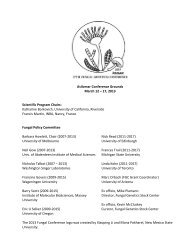Asperfest 4 Program - Fungal Genetics Stock Center
Asperfest 4 Program - Fungal Genetics Stock Center
Asperfest 4 Program - Fungal Genetics Stock Center
You also want an ePaper? Increase the reach of your titles
YUMPU automatically turns print PDFs into web optimized ePapers that Google loves.
9. Colonies from the filamentous fungus Aspergillus niger are highly differentiated in spite of cytoplasmic continuity. Ronald<br />
1 1 2 3 2 3 1<br />
P de Vries , Ana M Levin , Ana Conesa , Hildegard H. Menke , Manuel Talon , Noel NME van Peij , Han AB Wösten<br />
1 2<br />
Microbiology, Institute of Biomembranes, Utrecht University, Padulaan 8, 3584 CH Utrecht, The Netherlands; Centro de Genomica,<br />
3<br />
Instituto Valenciano de Investigaciones Agrarias, Moncada, Valencia, Spain; DSM Food Specialties, PO Box 1, 2600 MA Delft,<br />
The Netherlands.<br />
Filamentous fungi play an important role in element cycling by degrading organic material. The unexplored substrate at the periphery<br />
of the fungal mycelium and the partially degraded substrate in the mycelial centre are expected to have a major impact on local gene<br />
expression. However, the continuity of the cytoplasm in a fungal mycelium and the phenomenon of cytoplasmic streaming raise the<br />
question whether there are indeed spatial differences in the mRNA composition and physiology. This was studied in 7-day-old maltose<br />
and xylose grown colonies of Aspergillus niger. Differential changes were detected with respect to growth, protein secretion and gene<br />
expression. Differential gene expression was not limited to specific functional categories, but occurred genome-wide. However, some<br />
gene groups related to nutrient utilization displayed significantly increased levels of differential gene expression. These data will be<br />
presented as well as evidence for the involvement of transcriptional regulators that effect the expression of specific gene groups.<br />
10. The gene for the ubiquitin ligase regulator Cand1 is putatively split into two genes in the filamentous fungus Aspergillus<br />
nidulans. Elke U. Schwier, Martin Christmann, Krystyna Nahlik, Silke Busch and Gerhard H. Braus. Institut für Mikrobiologie und<br />
Genetik, Georg-August-Universität Göttingen, Grisebachstrasse 8, 37077 Göttingen, Germany; e-mail: eschwie@gwdg.de<br />
Ubiquitin dependent proteolysis plays an important role in many cellular processes in eukaryotes. Cullin containing ubiquitin ligases<br />
like the SCF (Skp1-Cullin-F-box protein) complex mark proteins for degradation by ubiquitinylation. It has been shown that the<br />
protein Cand1 binds to cullins. The Cand1 C-terminus blocks the SKP1 binding site of the SCF complex component Cul1 and affects<br />
thereby the assembly/disassembly of the ubiquitin ligase. The N-terminus of Cand1 buries the neddylation site on Cul1, which<br />
prevents its modification by Nedd8, an ubiquitin-like protein and alters the activity of the complex. In A. nidulans the gene encoding<br />
the putative homolog of human Cand1 seems to be split in two, both independent genes having about 20% identity to the human<br />
protein. Deletion of the A. nidulans gene coding for the protein Cand1_C similar to the c-terminal part of human Cand1 leads to a<br />
red hyphae phenotype. Cand1_C is expressed during vegetative growth but not during sexual development. It localizes to the nucleus<br />
and interacts with CulA, CulD and Cand1_N in the yeast two hybrid system. Currently we are investigating the function of the smaller<br />
protein Cand_N. The split cand1 gene makes the fungus A. nidulans an attractive model organism for studying the putative different<br />
functions of the two parts of the Cand1 protein.<br />
11. The Aspergillus nidulans nuclear pore complex protein An-Nup-2 plays a novel role in mitosis but is not essential for<br />
nuclear transport. Sarine Markossian and Stephen A. Osmani. The Ohio State University, Columbus, Ohio, USA.<br />
markossian.1@osu.edu<br />
The nuclear pore complex (NPC) regulates nuclear trafficking and is composed of ~30 subunits called nucleoporins (Nups). In yeast,<br />
Nup2p has been shown to facilitate nuclear transport. Unlike yeast Nup2p, Aspergillus nidulans Nup2 (An-Nup2) localizes to<br />
chromatin during mitosis but to the NPC during interphase. This indicates An-Nup2 may play a role during mitosis. An-nup2 is<br />
essential and its deletion causes mitotic defects. We therefore speculate that the localization of An-Nup2 to mitotic chromatin is<br />
important for mitosis. To test this hypothesis, a domain study was performed to define the An-Nup2 domain responsible for its mitotic<br />
translocation to chromatin and an antibody was generated against An-Nup2. A domain spanning from aa 400 to aa 1200, which<br />
encompasses a basic stretch of amino acids, a coiled coil region, and two potential nuclear localization sequences (NLS), is sufficient<br />
to locate An-Nup2-GFP to the NPC during interphase and to DNA during mitosis. The An-Nup2 antibody was used for<br />
immunofluorescence and successfully stained the nuclear periphery during interphase and chromatin during mitosis confirming the<br />
An-Nup2-GFP localization. Most importantly, the heterokaryon rescue technique was used to define if nuclear transport and/or mitosis<br />
is defective without An-Nup2. An-Nup2 deleted cells were not deficient in nuclear transport of NLS-dsRed suggesting that the<br />
lethality caused by An-Nup2 deletion is due to mitotic defects and not nuclear transport defects. In conclusion, there is emerging<br />
evidence that the localization of An-Nup2 to mitotic chromatin is essential for mitosis although An-Nup2 may not be essential for<br />
nuclear transport.<br />
4th International Aspergillus Meeting 8 Poster Abstracts











